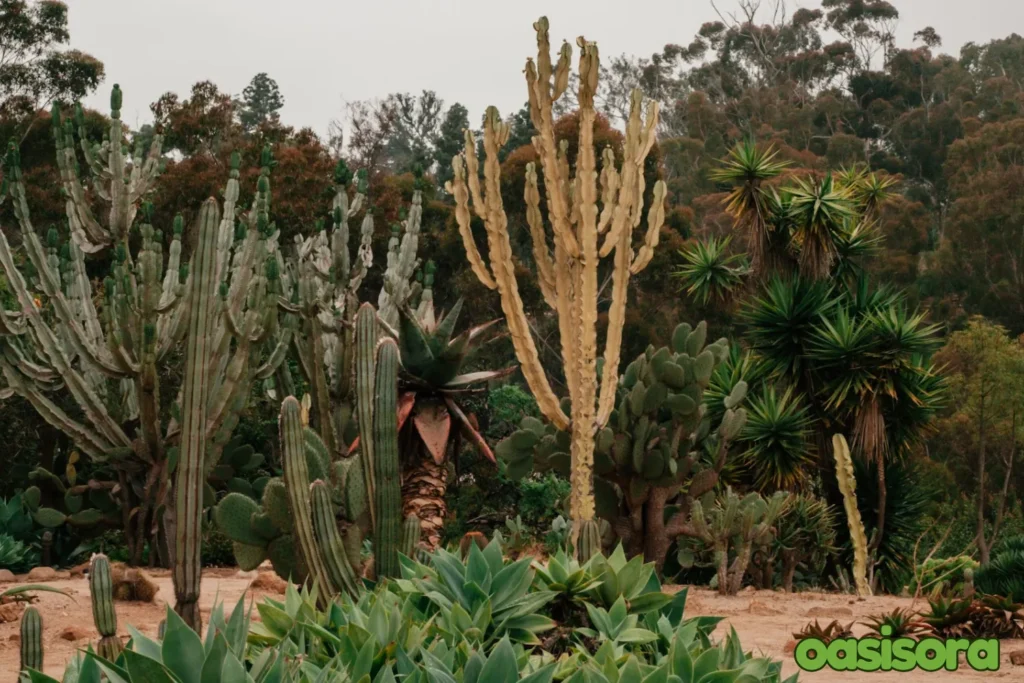
Cactus and succulents are perfect for creating bold, low-maintenance landscapes that thrive in dry climates. The cactus and succulents have the capacity to transform the desert gardens into living art galleries. Their unique shapes and adaptations create magnificent displays that grab attention. Cacti and succulents are pretty and good for the Earth. They need much less water (60-80 percent less) than other plants, which makes them perfect for saving water. Get ready for 21 inspiring cactus and succulent ideas that are perfect for warm climates!.
I’ll share my expertise and favorite designs to help you create stunning desert landscapes. So, stay tuned till the end of this post!.
TL; DR
Quick Highlights for Cactus and Succulent Ideas
- Explore a diverse range of species, from the iconic and majestic saguaros to tiny, adorable compact succulents.
- All selections flourish in USDA zones 8-11
- They need very little water, making them ideal for eco-friendly gardens.
- Varieties offer year-round attention with dramatic forms and seasonal blooms.
- Perfect for any space, whether you have a big yard or a small space.
Understanding Where Cacti and Succulents Thrive
Before we dive into amazing cactus and succulent ideas, let’s find out where they love to grow!
1. Climate and Growing Zones
Desert plants, including aloe, agave, and echeveria, thrive across USDA zones 8-11, each offering distinct growing conditions.
Zones 8-9 provide moderate desert conditions where many species of cacti, such as prickly pear and cholla, flourish but may need winter protection.
Succulents like Crassula and Sedum love the coast! They can handle salty air and strong winds. Also, Cacti like rebutia and mammillaria thrive in temperate zones with cooler winters.
- Regional Conditions: Local elevation, wind exposure, and rainfall patterns must be considered when drafting and executing a desert garden planting plan.
- Microclimates: Microclimates are small areas with special conditions. South-facing walls are warm and safe for sensitive plants like aloe vera. Some plants, like echeveria and crassula, prefer shade in the afternoon. While most native desert plants can handle extreme heat, some are more sensitive to frost.
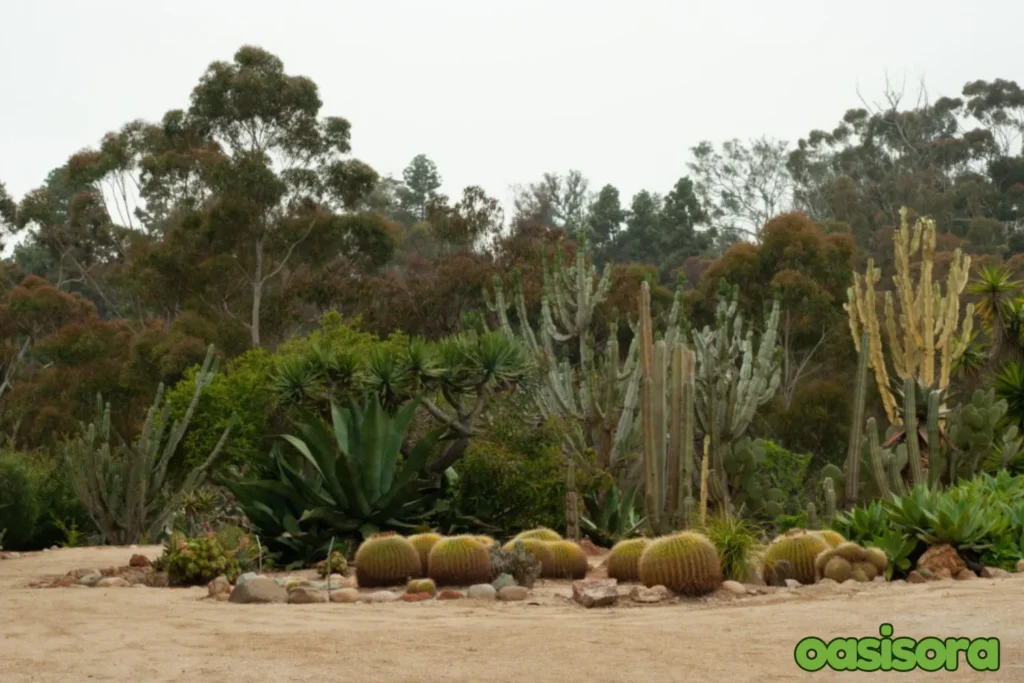
Climate and Growing Zones for cactus & succulanat plants
2. Soil and Drainage Essentials
Folks! Do remember, good drainage is key to growing happy desert plants! They can grow in poor soil but don’t like wet feet.
To help them thrive, read these instructions:
For outdoor gardens, mix 1 part compost with 2 parts sand or perlite. For pots, use special cactus and succulent potting mix or make your own with potting soil, sand, and perlite.
This helps water drain fast and prevents root rot, giving your plants the perfect balance of moisture and drainage!
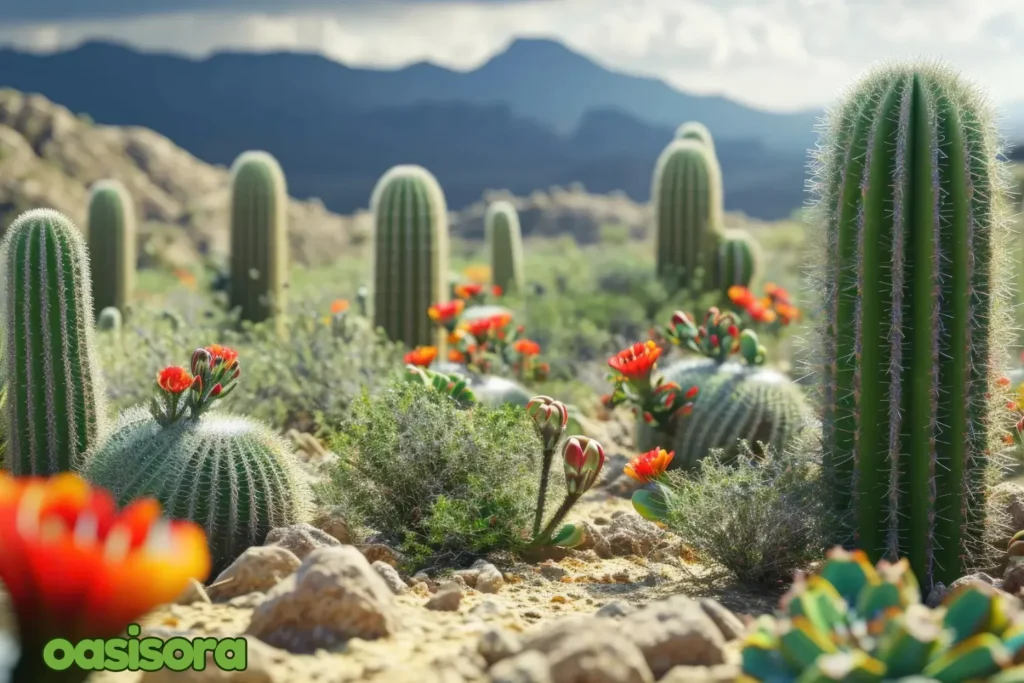
Soil for Cactus & Succulant plants
3. Sunlight and Placement
Most desert plants love full sun, needing at least 6 hours of direct sunlight daily.
However, some species like Fox Tail Agave and Aloe Vera prefer partial shade, especially during hot afternoons.
Consider the season when planting: Young plants may need shade their first summer, while winter plants benefit from warm spots near reflective surfaces or south-facing walls.
To adjust light exposure:
- Indoors: Move plants to brighter spots gradually to prevent sunscald.
- Outdoors: Provide temporary shade during extreme heat or for newly planted species.
- Acclimate new plants to full sun over time to prevent damage.
Top 21 Cactus and Succulent Ideas for 2025
Get ready to create a beautiful and easy-to-care sustainable desert garden yourself with these striking cactus and succulent ideas. Read till the end!
Iconic and Eye-Catching Centerpieces
These lovely centerpieces will help you create an incredible landscape in your outdoor area!
They will add a touch of desert style and shine that will amaze your family and friends.
1. Saguaro Cactus (Carnegiea gigantea)
AKA: Giant Cactus, Sahuaro, Master of the Desert
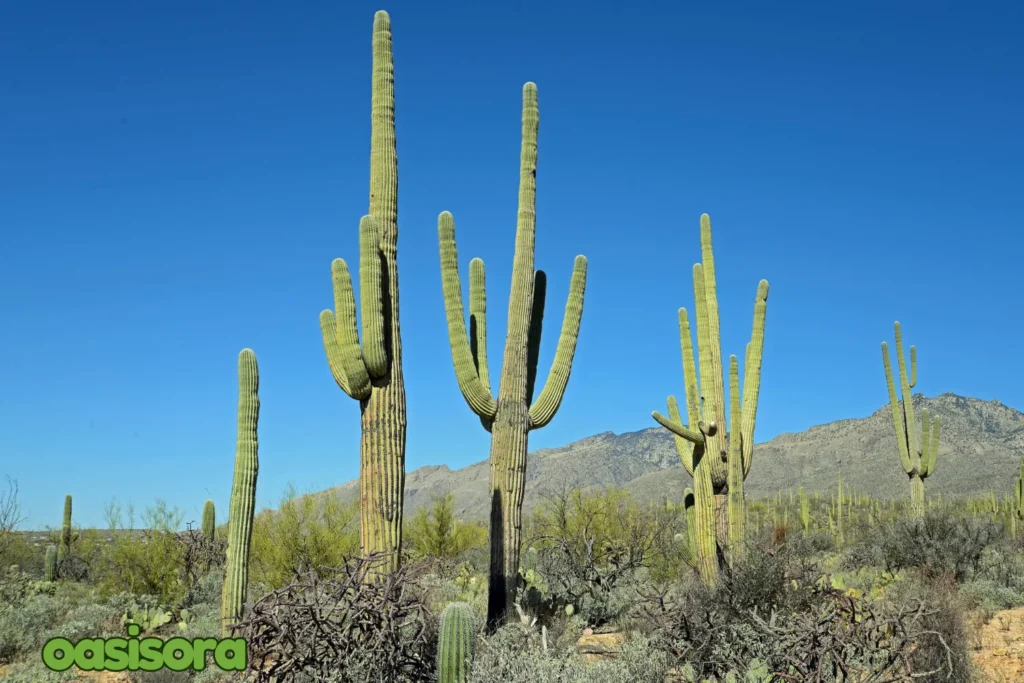
Saguaro Cactus
Meet the Saguaro cactus, a famous desert icon! It’s known for growing super tall and getting unique arms after 75-100 years – a really cool and special feature.
Its slow growth and impressive size make it a stunning focal point in desert gardens. The Saguaro also produces beautiful white flowers that bloom at night in late spring, which are Arizona’s official state wildflower.
This amazing cactus provides a vital home for desert animals, with birds nesting in holes created by woodpeckers in mature plants.
| Native to: | Sonoran Desert |
| Climate Regions: | Hot semi-arid climate (BSh) and Hot desert climate (BWh) |
| USDA Zones: | 8-11 |
| Soil Type: | Well-draining, sandy soil, rocky |
| Pros: | It has a longer lifespan, a classy desert appearance, a valued animal habitat, and white flowers that bloom at night. |
| Considerations: | It’s a protected species and needs special care, grows slowly, and also needs lots of space. |
2. Organ Pipe Cactus (Stenocereus thurberi)
AKA: Sweet Organ Pipe, Pitaya Dulce, Arizona Queen of the Night
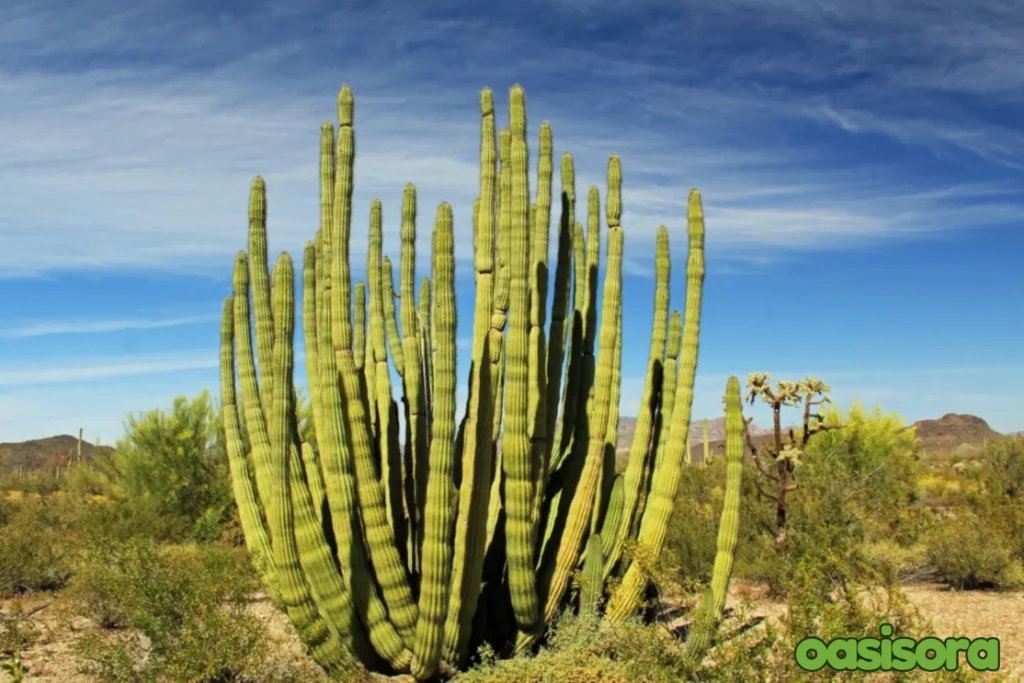
Organ Pipe Cactus
The Organ Pipe Cactus is amazing!It has many stems growing from one base and can grow really tall up to 26 feet!
It’s a natural desert wonder. Its big flowers bloom at night and turn into sweet, edible fruits that have been harvested by desert communities for centuries.
| Native to: | Southwestern United States, Mexico |
| Climate Regions: | Hot desert weather (BWh) and Hot semi-arid climate (BSh) |
| USDA Zones: | 9-11 |
| Soil Type: | Sandy, gravelly soil with excellent drainage |
| Pros: | Looks like a column, and blooms beautiful magenta flowers at night, making it a fascinating sight. It also grows sweet, edible fruit and forms impressive clusters over time. |
| Considerations: | It needs support when young, can’t handle frost and requires a lot of space. It can also be difficult to locate and takes time to become strong. |
3. Golden Barrel Cactus (Echinocactus grusonii)
AKA: Mother-in-Law’s Cushion, Golden Ball, Mother-in-Law’s Seat
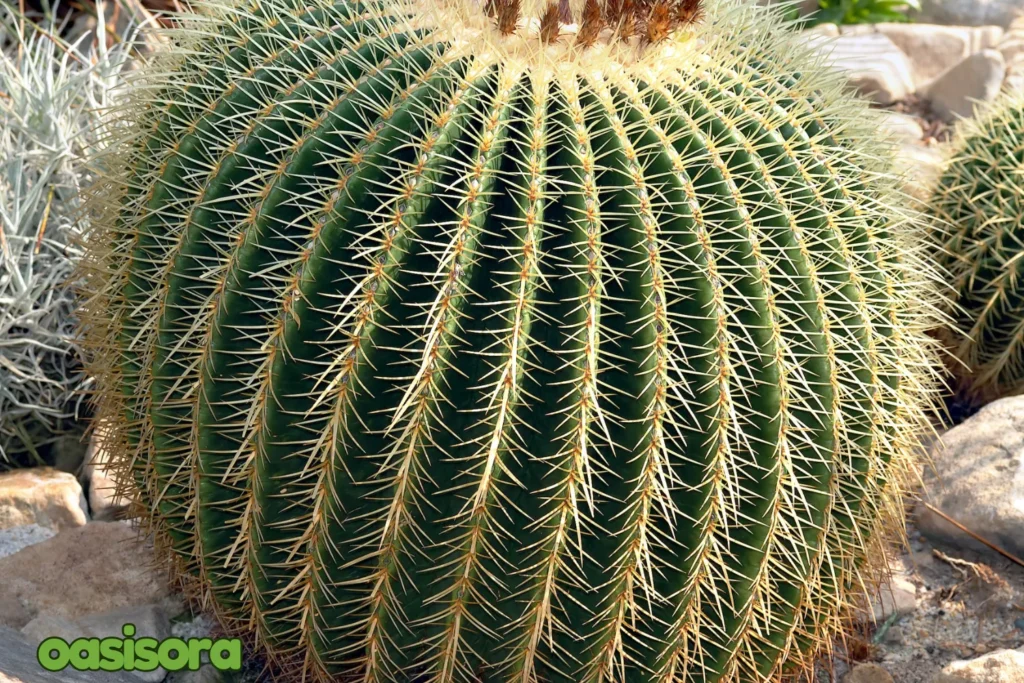
Golden Barrel Cactus
The Golden Barrel Cactus is a great cactus and succulent idea for desert gardens. It is round, has bright golden spines, and looks amazing in sunlight.
Its strong look makes it a perfect focal point in gardens, and gardeners love it for its dramatic look.
| Native to: | Central Mexico |
| Climate Regions: | Hot desert climate (BWh) or Hot semi-arid temperature (BSh) |
| USDA Zones: | 9-11 |
| Soil Type: | Very well-draining mineral soil |
| Pros: | It’s round, has bright golden spines, and pretty yellow flowers. It’s perfect for pots, lives a long time, and adds a burst of color to any garden. |
| Considerations: | Grows slowly, gets heavy, and needs good drainage, but watch out for sunburn and sharp spines! |
4. Blue Agave (Agave tequilana)
AKA: Mexican Blue Agave, Tequila Agave, and Weber’s Blue Agave and Weber Azul
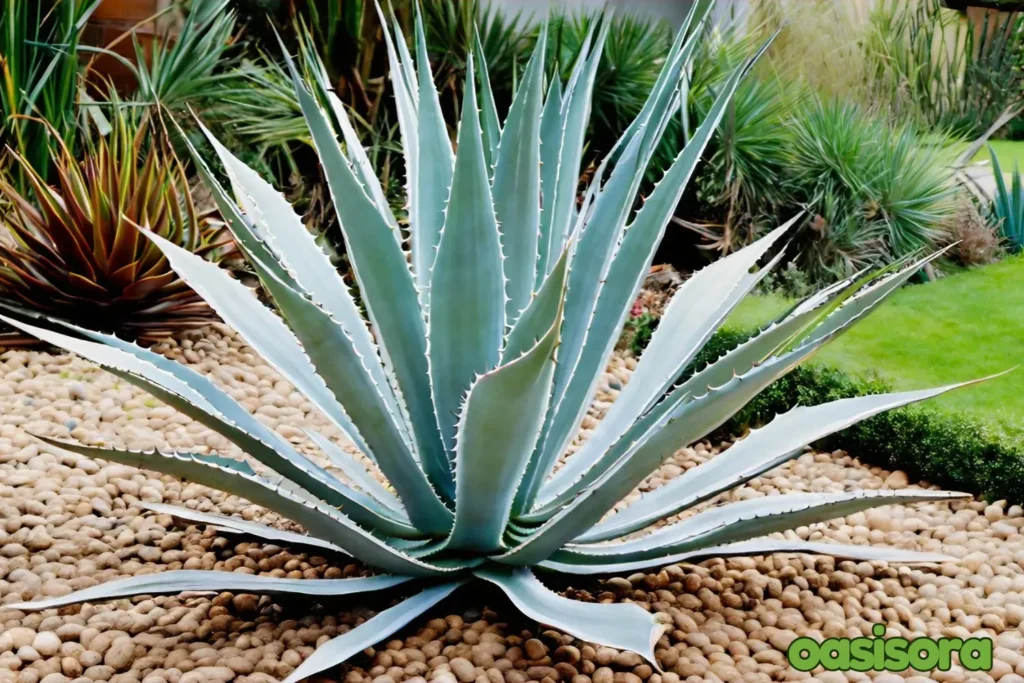
Blue Agave
The Blue Agave is a beautiful plant with perfectly round, blue-gray leaves. Famous for being the source of tequila, it adds drama and structure to desert gardens with its large, fleshy leaves and cool visual effect.
| Native to: | Mexico |
| Climate Regions: | Hot desert climate (BWh), Hot semi-arid climate (BSh); requires significant protection in Cold desert climate (BWk) and Cold semi-arid climate (BSk) |
| USDA Zones: | 9-11 |
| Soil Type: | Well-draining sandy, rocky soil |
| Pros: | This agave stands out with its blue-gray color and unique shape. It’s low-maintenance, needs little water, and has commercial value. Plus, it can live a long time before blooming. |
| Considerations: | This agave has sharp spines and needs caution. It blooms once, then dies. It requires a lot of space and can be sensitive to frost and extreme weather, especially when young. |
Compact Beauties for Small Spaces
If you have a small yard or tiny spots. Below cactus and succulent ideas are ideal for you as they can thrive in your yard’s tight spaces like windowsills, desks, or cozy garden nooks, adding a touch of green charm to any area.
5. Old Man Cactus (Cephalocereus senilis)
AKA: White Persian cat cactus, Old Man of Mexico, and Bunny Cactus
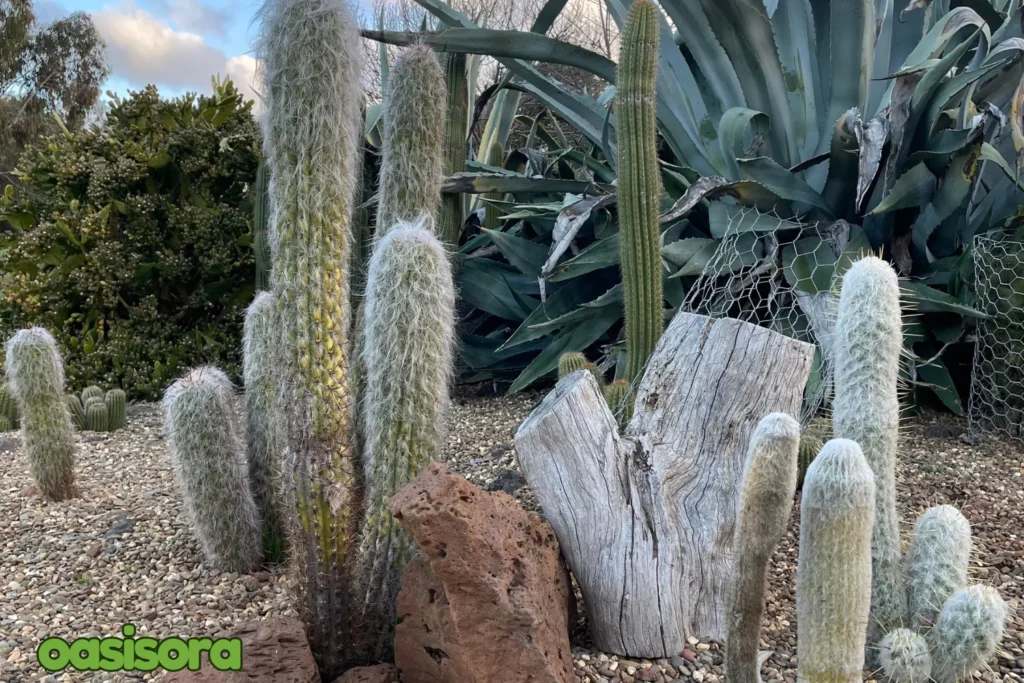
Old Man Cactus
This spectacular cactus is recognizable by its long, silvery-white hairs. It has soft, flowing spines that contrast with rigid desert plants, adding unique texture and a striking silver accent to gardens beautifully.
It goes beyond being pretty, adding unique texture and a striking silver accent that elevates desert garden designs.
| Native to: | Mexico |
| Climate Regions: | Hot desert climate (BWh) or Hot semi-arid weather (BSh) |
| USDA Zones: | 9-11 |
| Soil Type: | Very well-draining mineral soil |
| Pros: | Its stunning shape, distinctive white hair-like spines, and lovely night-blooming flowers make this cactus stand out. It grows well in containers. |
| Considerations: | This cactus needs protection from heavy rain and cold temps below 30°F, and grows slowly. Its hair-like spines can collect debris, needing occasional cleaning. |
6. Aloe Vera
AKA: True Aloe, Medicinal Aloe, Burn Plant
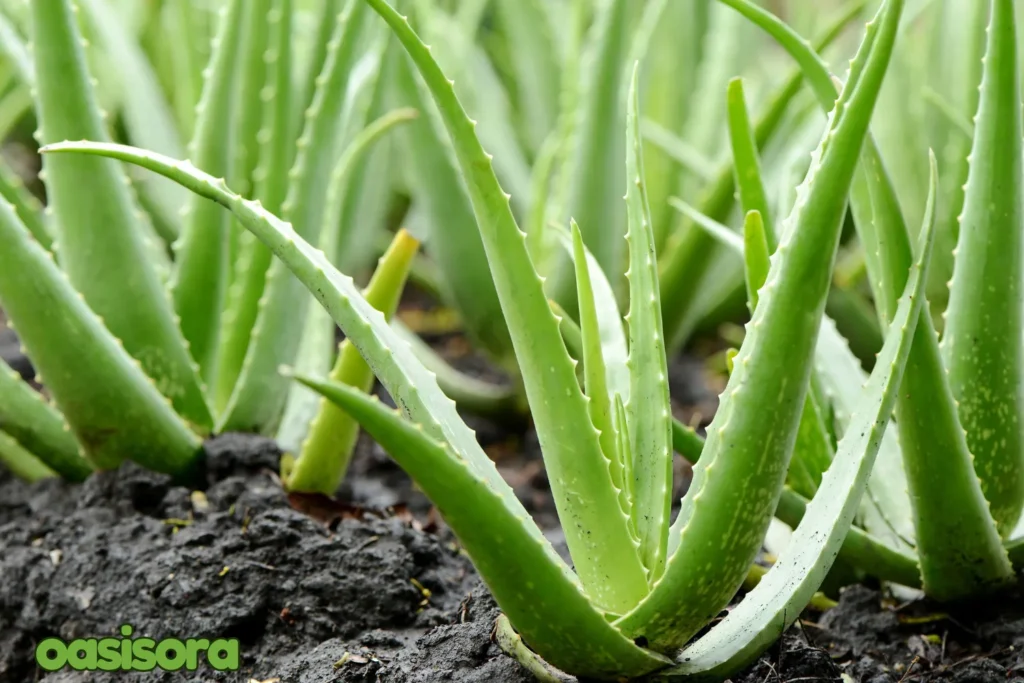
Aloe Vera
If you are a plant lover then aloe Vera is familiar to you! Isn’t it? This well-liked succulent is valued for both its beautiful look and its medicinal and healing gel.
Hummingbirds and other pollinators are drawn to its tall spikes of brilliant blooms, and its fleshy, serrated leaves grow in a lovely rosette pattern.
| Native to: | Arabian Peninsula |
| Climate Regions: | Hot semi-arid weather (BSh) or Hot desert climate (BWh) |
| USDA Zones: | 9-11 |
| Soil Type: | Sandy, well-draining soil |
| Pros: | This cactus and succulent idea has various uses in medicine, minimal care needed, and container versatility. It also produces beautiful flowers and offsets for easy propagation. |
| Considerations: | This succulent needs protection from frost and well-draining soil to thrive. In ideal growing conditions, it can become invasive and need to be carefully managed. |
7. Zebra Haworthia (Haworthia fasciata)
AKA: Striped Succulent, Pearl Plant, Pointed Cushion
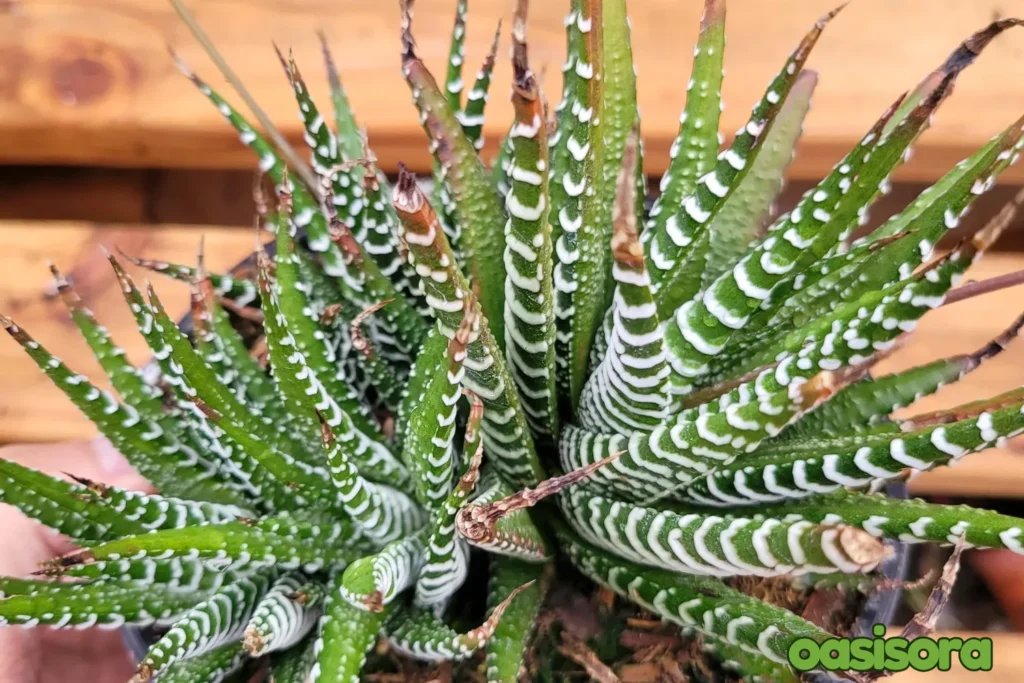
Zebra Haworthia
This Cactus and Succulent Idea is quite interesting! As the name suggests, Zebra Haworthia! Isn’t that amazing?
This little succulent’s unique white stripes add texture and visual appeal to compact spaces and container gardening.
Its compact size makes it ideal for dish gardens or as an accent plant among larger desert plants.
| Native to: | South Africa |
| Climate Regions: | Hot semi-arid climate (BSh), Hot desert climate (BWh), Cold semi-arid climate (BSk) |
| USDA Zones: | 9-11 |
| Pros: | This succulent is ideal for containers due to its small size. It thrives indoors, boasts distinctive white striping, and easily clusters to form a beautiful display. |
| Considerations: | This succulent requires partial shade, especially from the intense afternoon sun. It grows slowly and is sensitive to overwatering, making careful watering habits essential for its health. |
8. Lithops (Living Stones)
AKA: Pebble Plants, Living Stones, and Flowering Stones
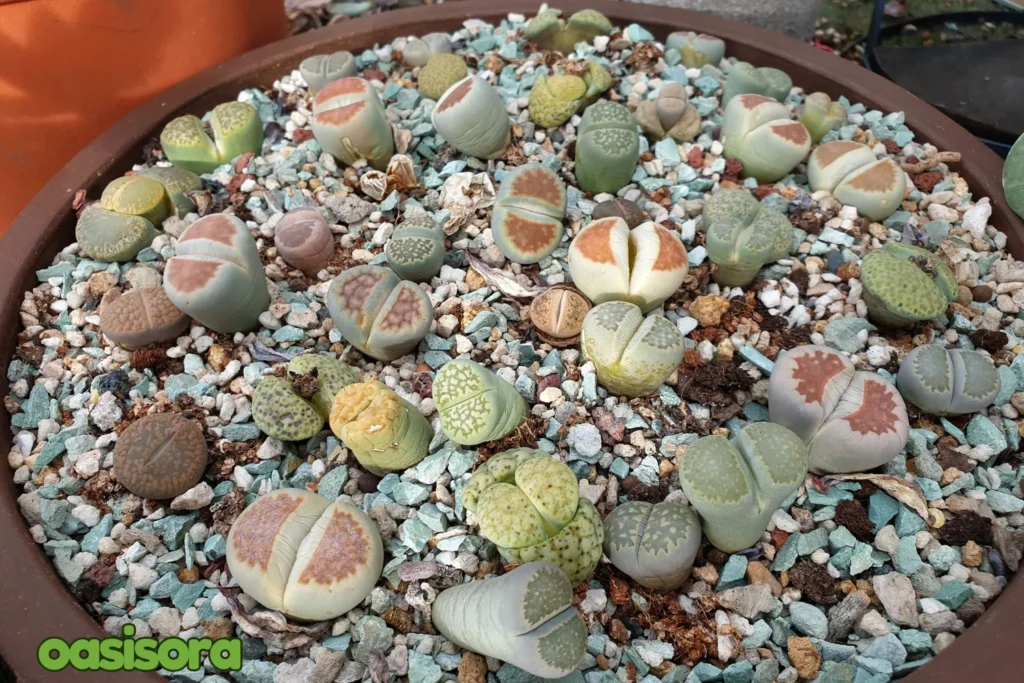
Lithops
This unique succulent’s stone-like appearance adds fascinating texture to container gardens and small spaces.
Its compact size makes it ideal for dish gardens or as an accent plant among larger desert plants.
Lithops display a charming array of plain hues, comprising shades of tan, olive, orange, and rarely blues, blending faultlessly with their natural stone-like environment.
| Native to: | Southern Africa |
| Climate Regions: | Hot semi-arid climate (BSh), Hot desert climate (BWh) |
| USDA Zones: | 10-11 |
| Pros: | This succulent is supreme for containers as it has a small size. It thrives indoors, boasts a unique stone-like appearance, and produces beautiful flowers. |
| Considerations: | This succulent needs at least six hours of direct sunlight a day, and requires careful watering, as it’s sensitive to overwatering. It prefers well-draining soil and partial shade. |
Sculptural and Architectural Picks
Add texture and boldness to your garden or patio with these cactus and succulent ideas.
These unique plants feature striking shapes and forms that create visual interest and depth.
9. Whale’s Tongue Agave (Agave ovatifolia)
AKA: Whale’s Tongue, Giant Agave, Silver Agave
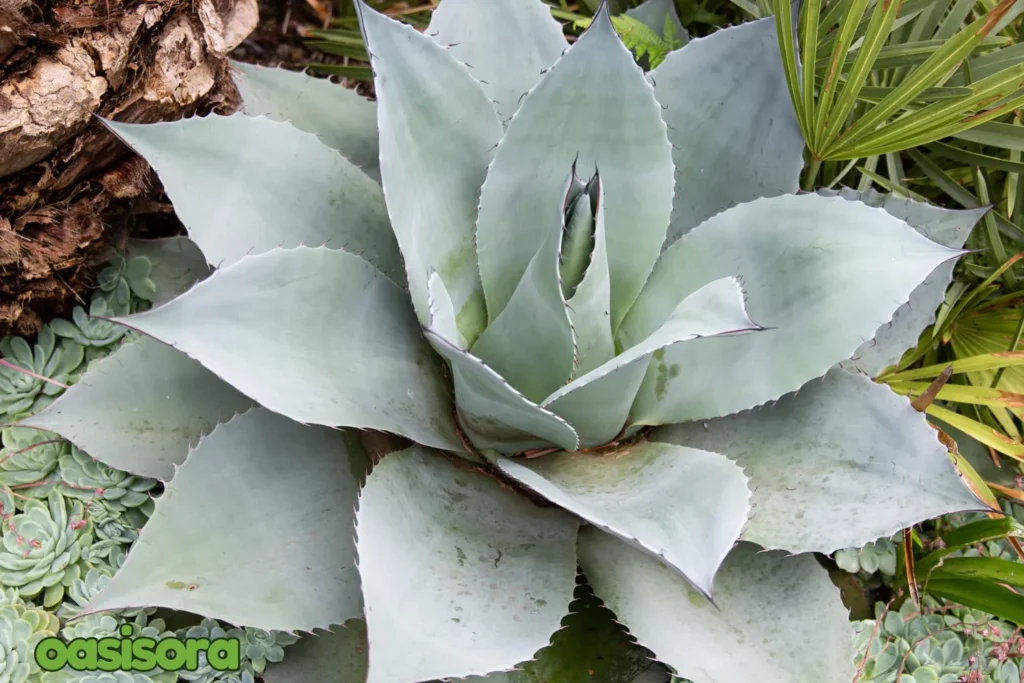
Whale’s Tongue Agave
What’s behind the curious name Whale’s Tongue?
Let me tell you! Whale’s Tongue Agave has beautiful, gray-blue leaves that resemble a whale’s tongue!
Desert gardeners love it for its perfect shape and small size. Unlike other big agaves, it stays small but makes a big impact. Its powdery blue color looks amazing with desert rocks and gravel.
| Native to: | Mexico |
| Climate Regions: | Cold desert climate (BWk), Hot desert climate (BWh), Hot semi-arid climate (BSh) |
| USDA Zones: | 7-11 |
| Soil Type: | Well-draining rocky soil that tolerates limestone |
| Pros: | it has an outstanding cold hardiness, compacted growth habit, powdery blue-gray color, drought tolerant, and low maintenance. |
| Considerations: | It possesses sharp leaf tips, and dies after flowering, needing good spacing, slow maturation, and sensitivity to extreme heat. |
10. Fox Tail Agave (Agave attenuata)
AKA: Swan’s Neck Agave, Lion’s Tail Agave, or Dragon Tree Agave
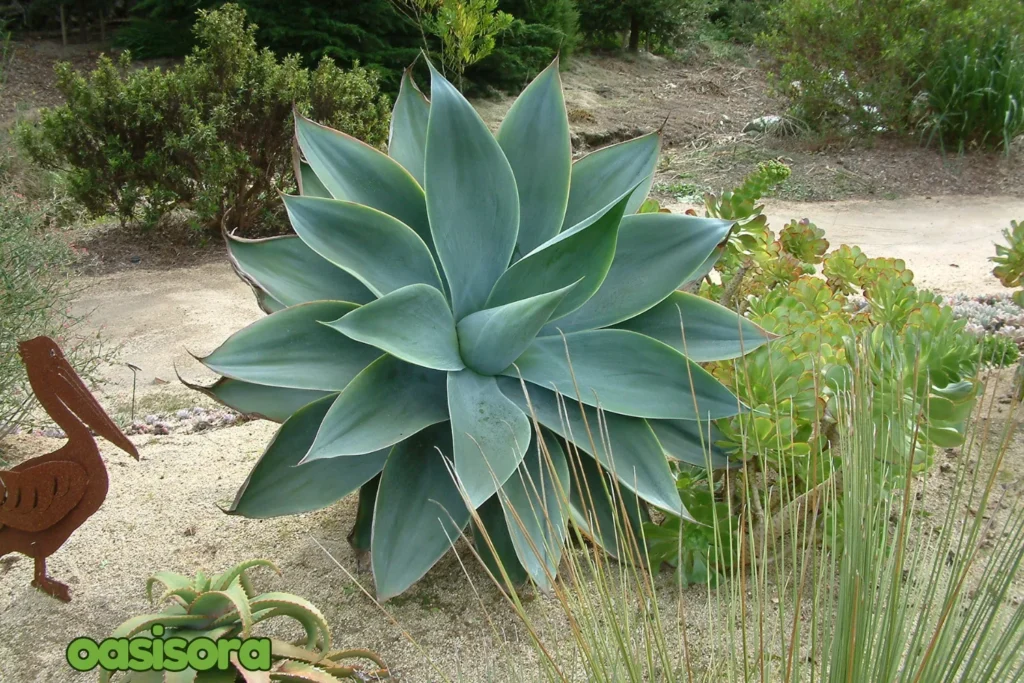
Fox Tail Agave
Meet the Fox Tail Agave, a desert charmer with a curly twist!
This cactus and succulent idea is unique among the agaves I have discussed. Fox Tail Agave has soft, spineless leaves for a tropical look in desert gardens
Its curved flower spike looks like a fox’s tail, adding drama. This plant is special because it can thrive in partial shade, making it great for different garden spots.
| Native to: | Central Mexico |
| Climate Regions: | Hot semi-arid climate (BSh) |
| USDA Zones: | 9-12 |
| Soil Type: | Well-draining fertile soil |
| Pros: | Fox Tail Agave features smooth spineless leaves, a unique curved flower spike, and a tropical appearance. It’s also safe for high-traffic areas and can thrive in shade. |
| Considerations: | It requires regular watering and some shade, also it is more susceptible to drought and frost and cares it more. |
11. Queen Victoria Agave (Agave victoriae-reginae)
AKA: Royal Agave, Queen Agave, Royal Crown Agave
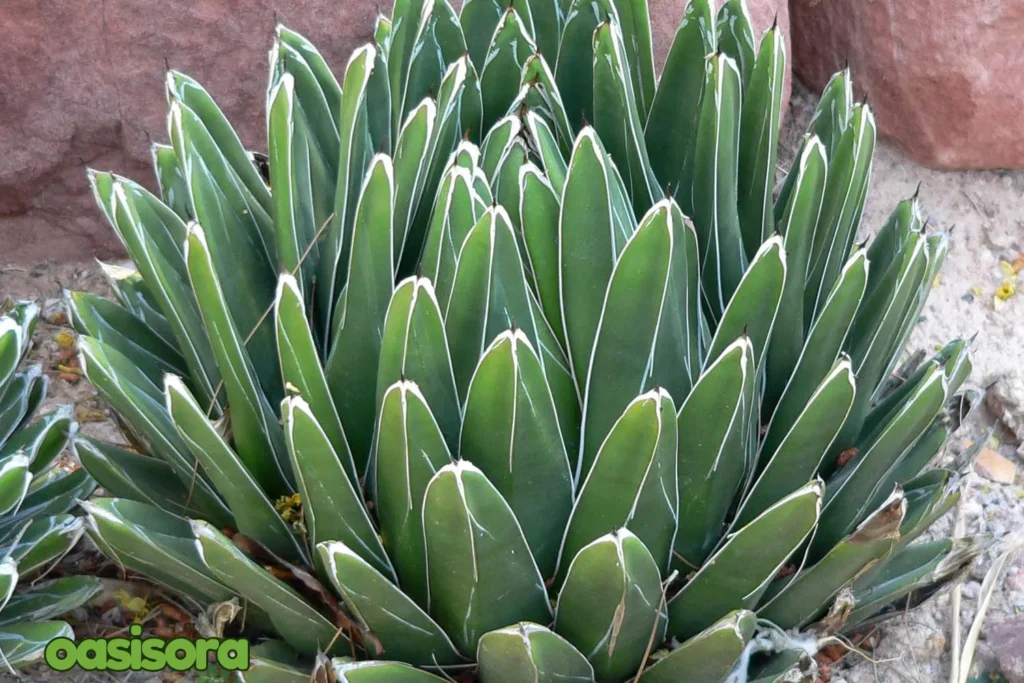
Add a touch of royalty to your desert yard with Queen Victoria Agave!
This compact agave is a favorite among gardeners. It has beautiful white lines on dark green leaves in a neat pattern. Its small size and slow growth make it great for pots and small gardens.
The symmetrical shape makes it a living work of art, loved by collectors.
| Native to: | Mexico |
| Climate Regions: | Cold desert climate (BWk), Hot desert climate (BWh), and Hot semi-arid climate (BSh) |
| USDA Zones: | 7-11 |
| Soil Type: | Very well-draining rocky or sandy soil |
| Pros: | It grows compactly and symmetrically, with beautiful white markings. Thrives in containers, lives a long life (25+ years), and is surprisingly cold hardy. |
| Considerations: | Be aware that this agave grows slowly, has sharp leaf tips, and blooms only once before dying. It also requires very well-draining soil. |
12. Desert Spoon (Dasylirion wheeleri)
AKA: Common Sotol, Spoon Flower, Wheeler Sotol, Desert Candle
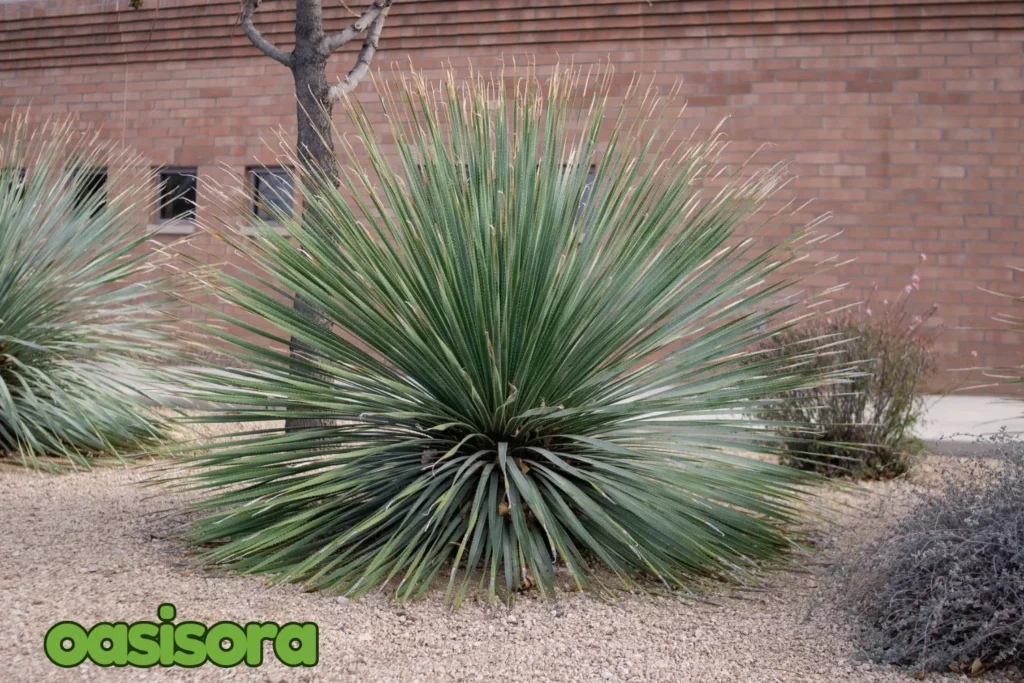
Desert Spoon
The Desert Spoon makes a big statement with its unique, fountain-like shape. Its long, blue-gray leaves curve outward from a central point.
As it matures, it grows a tall flower stalk up to 15 feet high. This cactus and succulent idea can add a spectacle to your landscape.
| Native to: | Southwestern United States and Mexico |
| Climate Regions: | Cold desert climate (BWk), Hot desert climate (BWh), Hot semi-arid climate (BSh), Cold semi-arid climate (BSk) |
| USDA Zones: | 8-11 |
| Soil Type: | Well-draining rocky or sandy soil |
| Pros: | It has a long lifespan, is absolutely symmetrical, and is resistant to deer and drought. It would be a great focal piece for any garden. |
| Considerations: | This plant has sharp leaves, grows slowly, and needs a mate to produce seeds. It also requires well-draining soil and can be tricky to move once established. |
Easy-Care and Practical Choices
Bring beauty to your space without the fuss! These low-maintenance options offer stunning results with minimal effort.
13. Prickly Pear (Opuntia species)
AKA: Nopal Cactus, Indian Fig, Barbary Fig
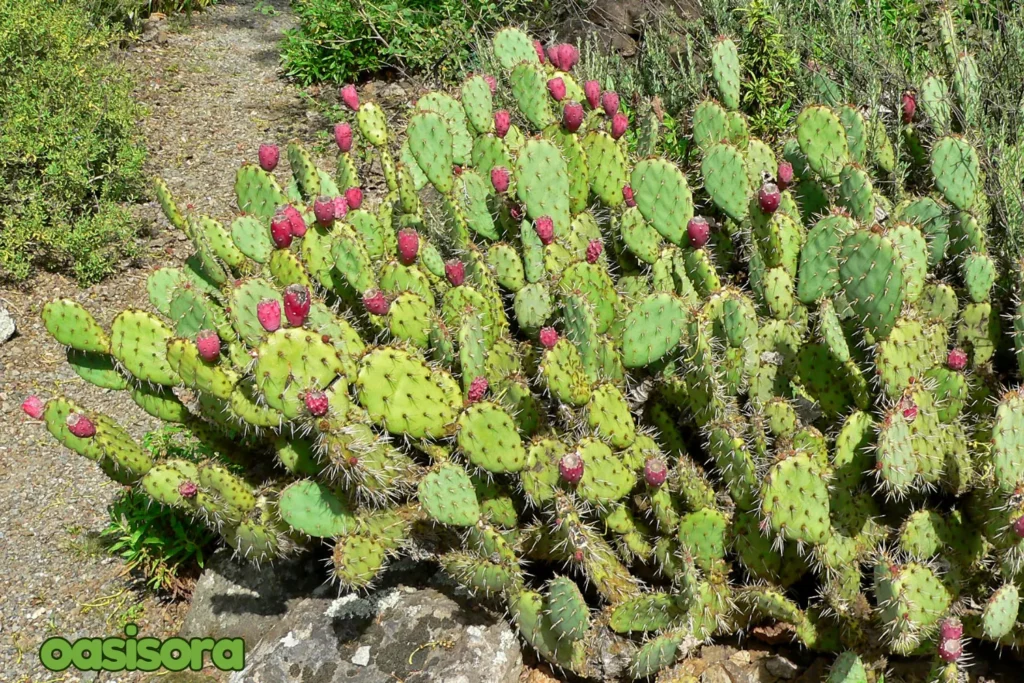
Prickly Pear
Discover my stunning cactus and succulent idea with the prickly pear!
This super versatile cactus is perfect for desert gardens. This plant has unique paddle-shaped parts that can be trimmed to shape.
It produces: vibrant flowers and delicious edible fruits. And, it’s surprisingly strong and can grow well in many different climates!
| Native to: | Americas |
| Climate Regions: | Hot desert climate (BWh), Cold desert weather (BWk) and also Hot semi-arid climate (BSh) |
| USDA Zones: | 4-11 (types dependent) |
| Soil Type: | Well-draining sandy or stony soil, bears-deprived soil |
| Pros: | It is very resilient, yields edible fruits and pads, and is simple to grow. Plus, it showcases vibrant flowers in many colors and helps control erosion. |
| Considerations: | Can spread quickly if not kept in check. Its tiny spines can be annoying, and regular pruning is a must. When harvesting fruit, handle it with care. |
14. Elephant Bush (Portulacaria afra)
AKA: Elephant’s Foot, Dwarf Jade Plant, Small-leaf Jade, Porkbush
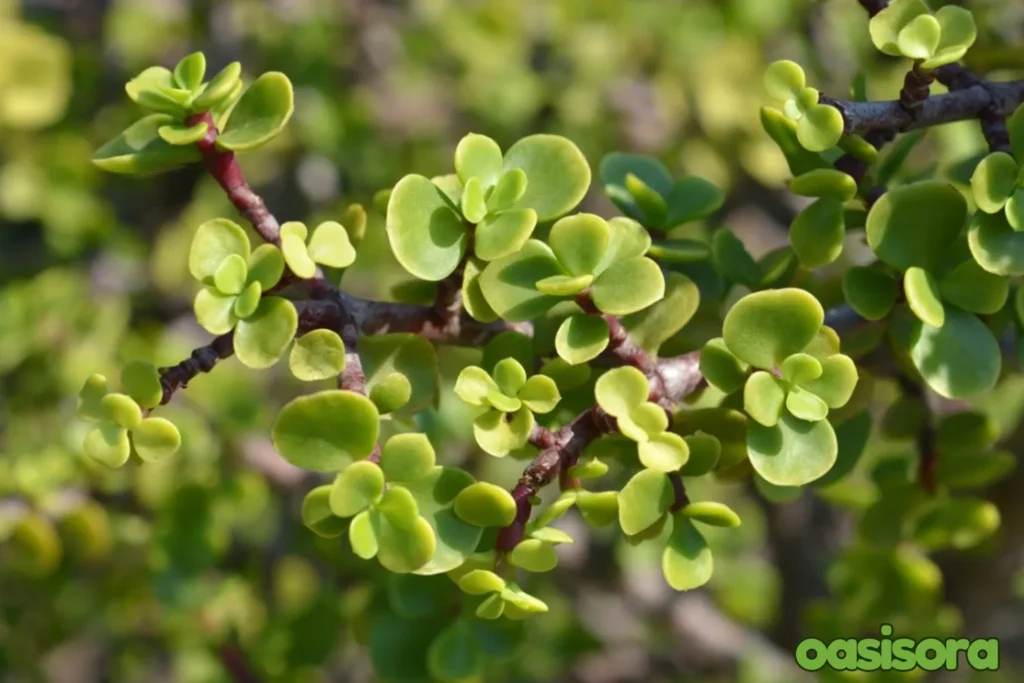
Elephant Bush
Learn about the Elephant Bush, a super-versatile cactus and succulent idea!
It can be cultivated as a groundcover, a bonsai, or a tiny shrub. It has a lovely, thick pattern that is easy to modify with pruning because of its adorable round leaves and reddish stems.
Plus, it thrives in containers and landscapes!
| Native to: | South Africa |
| Climate Regions: | Hot desert climate (BWh) and Hot semi-arid weather (BSh) |
| USDA Zones: | 9-11 |
| Soil Type: | Well-draining succulent mix |
| Pros: | This plant is a low-maintenance superstar with versatile growth, rapid growth, impressive drought tolerance, and easy propagation. |
| Considerations: | This frost-sensitive plant needs careful hydration, proper lighting, and frequent pruning to avoid harm. |
15. Silver Jade (Crassula arborescens)
AKA: Blue Bird Jade Plant, Chinese Jade, Blue Jade
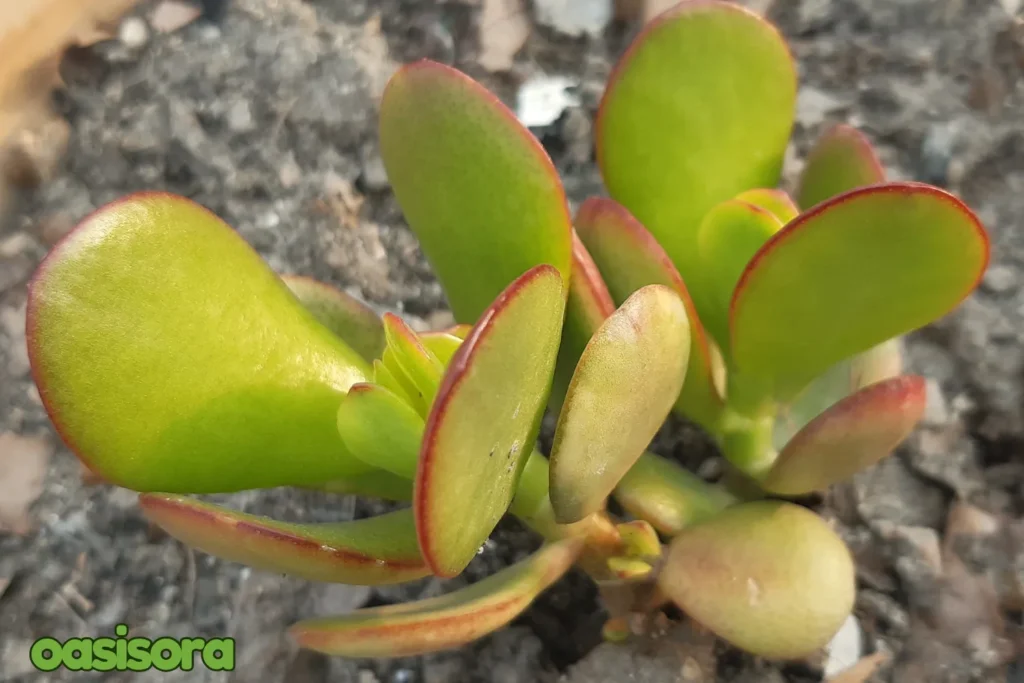
Silver Jade
Silver Jade is a stunning addition to desert gardens!
Its round, blue-gray leaves with red edges are topped with pink star-shaped flowers in winter. This little succulent is ideal for containers and landscapes since it can grow into a thick shrub or small tree.
It is a great choice for water-wise gardening with a year-round appeal because of its distinctive hues and resistance to drought.
| Native to: | South Africa |
| USDA Zones: | 9-11 |
| Climate Regions: | Hot semi-arid climate (BSh) and Hot desert temperatures (BWh) |
| Soil Type: | Well-draining succulent mix with added mineral content |
| Pros: | A stunning succulent with blue-gray foliage, winter blooms, and drought tolerance – perfect for containers, bonsai, and easy propagation. |
| Considerations | : Needs some extra care! Sensitive to frost, needs shade in hot sun, regular pruning, good drainage, and careful handling to prevent toppling. |
16. Golden Jade (Crassula ovata ‘Hummel’s Sunset’)
AKA: Money Plant, Sunset Jade, Golden Money Tree
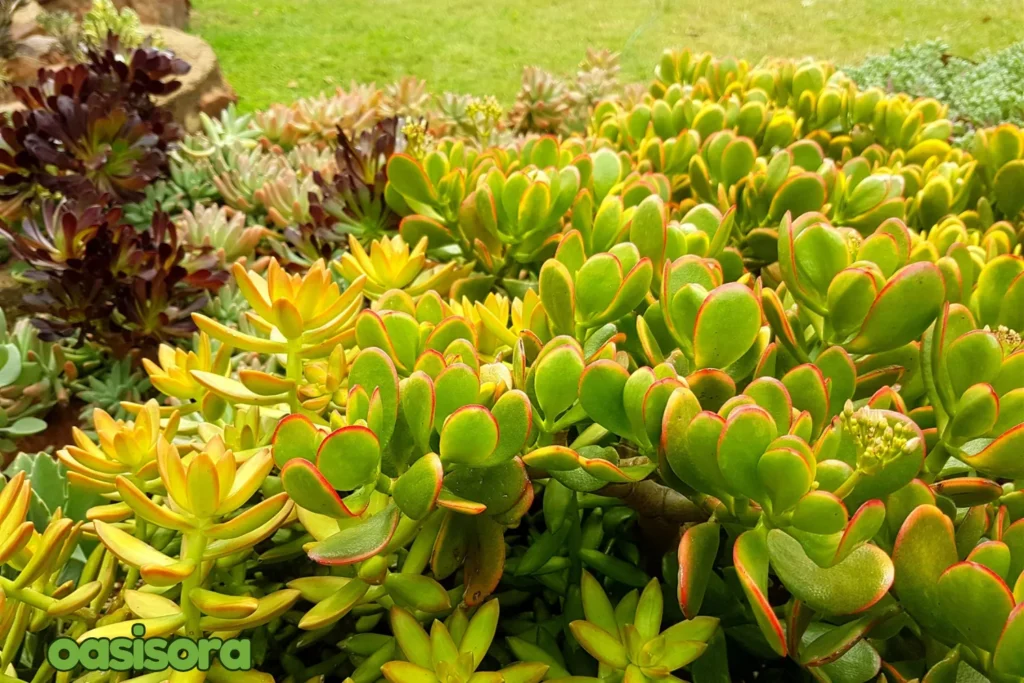
Golden Jade
Hello! Golden lovers! This golden cactus and succulent idea is for you especially!
Golden Jade is a beautiful jade plant variety. Its leaves turn golden-yellow with red tips in sunlight. This compact succulent creates a stunning color show that gets brighter in cooler months.
Its branching shape makes it perfect for bonsai or adding a pop of color to containers.
| Native to: | Cultivated variety (Parent species from South Africa) |
| USDA Zones: | 10-11 |
| Climate Regions: | Hot desert climate (BWh) or Hot semi-arid weather (BSh) |
| Soil Type: | Fast-draining moist soil with 50-60% inorganic content |
| Pros: | It has a vibrant gold and red coloration, compact growth, and long-lasting beauty. Perfect for containers and thrives with minimal watering. |
| Considerations: | Needs extra care, more sensitive to cold than regular jade, requires bright light, hates wet feet, can get top-heavy, and needs protection from winter chill below 40°F. |
Vibrant and Unique Statement Plants
Boost your desert yard space with these show-stopping cactus and succulent ideas! They will add a pop of color and mystery to your collection with their matchless appeal and evergreen beauty.
17. Paddle Plant (Kalanchoe thyrsiflora)
AKA: Flapjack Plant, Desert Cabbage, White Lady, Paddle Kalanchoe
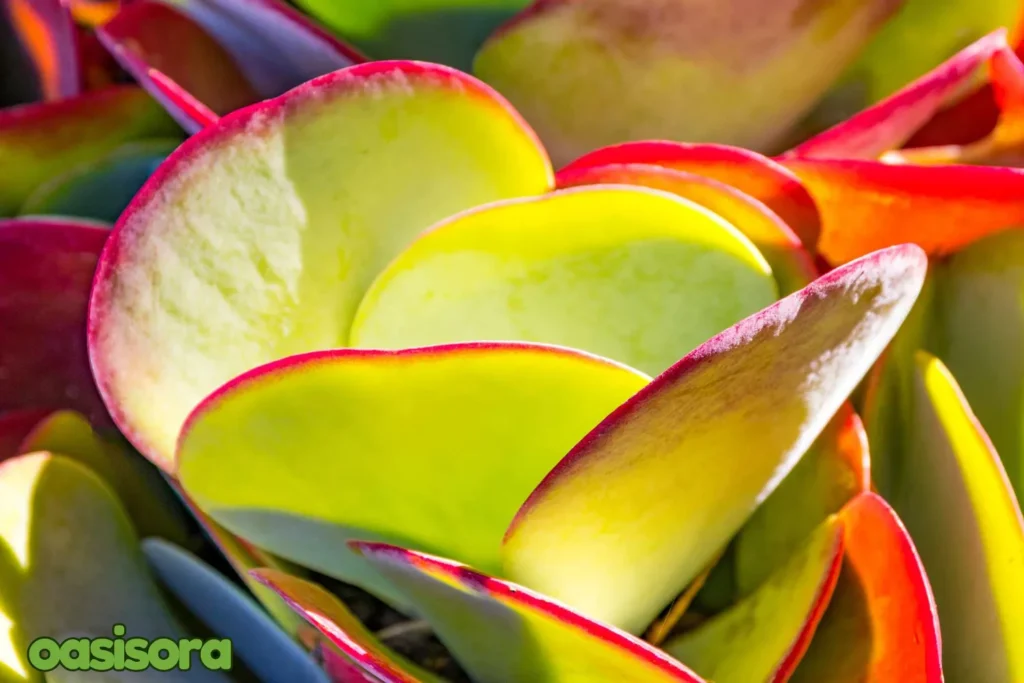
Paddle Plant
The Paddle Plant is a stylish succulent with paddle-shaped leaves in tight clusters.
In full sun, the leaves take on a beautiful reddish hue. This compact plant adds a modern touch to gardens and containers. When winter arrives, the leaves develop bright red edges, creating an eye-catching display.
| Native to: | South Africa |
| Climate Regions: | Hot semi-arid climate (BSh), Hot desert climate (BWh), Cold semi-arid climate (BSk) with frost protection |
| USDA Zones: | 9-12 |
| Soil Type: | Well-draining succulent mix |
| Pros: | it has outstanding leaf color changes and also it is a container-suitable plant with easy propagation, and architectural form, and is drought tolerant. |
| Considerations: | You should protect in winter, handle leaves with care, replant after flowering, and avoid overwatering to this plant type. |
18. Echeveria (Various species)
AKA: Mexican Rosettes, Mexican Snowballs, Variegated Wax Plant
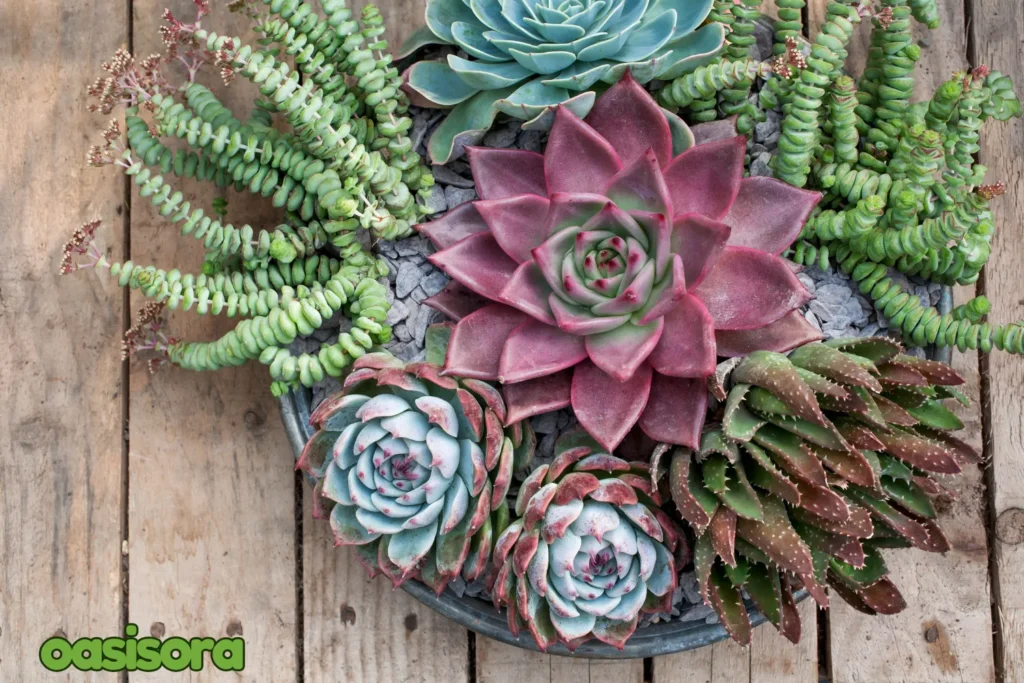
Echeveria
Consider Echeveria if you’re searching for a cactus and succulent idea that is both trendy and ecologically friendly. The thick, juicy leaves of this lovely succulent are arranged in tidy clusters
. Echeveria gives pots and gardens an extra touch of style. It is also a beneficial plant that assists the ecology and butterflies, making it an excellent option for those who enjoy the outdoors.
| Native to: | Mexico |
| Climate Regions: | Hot desert climate (BWh) and also Hot semi-arid climates(BSh) |
| USDA Zones: | 9-11 |
| Soil Type: | Well-draining succulent mix |
| Pros: | This plant creates gorgeous, colorful rosettes that brighten up any room! It’s also: super easy to care, low-maintenance, drought-tolerant, and available in many beautiful colors. |
| Considerations: | Overwatering it can might sick it. It also can’t handle frost, so keep it cozy during winter. Its colors may somewhat fade if you place it in the shadow. |
19. String of Pearls (Senecio rowleyanus)
AKA: Rosary vine, Chain of pearls, Bead plant, Irish beads, Necklace plant
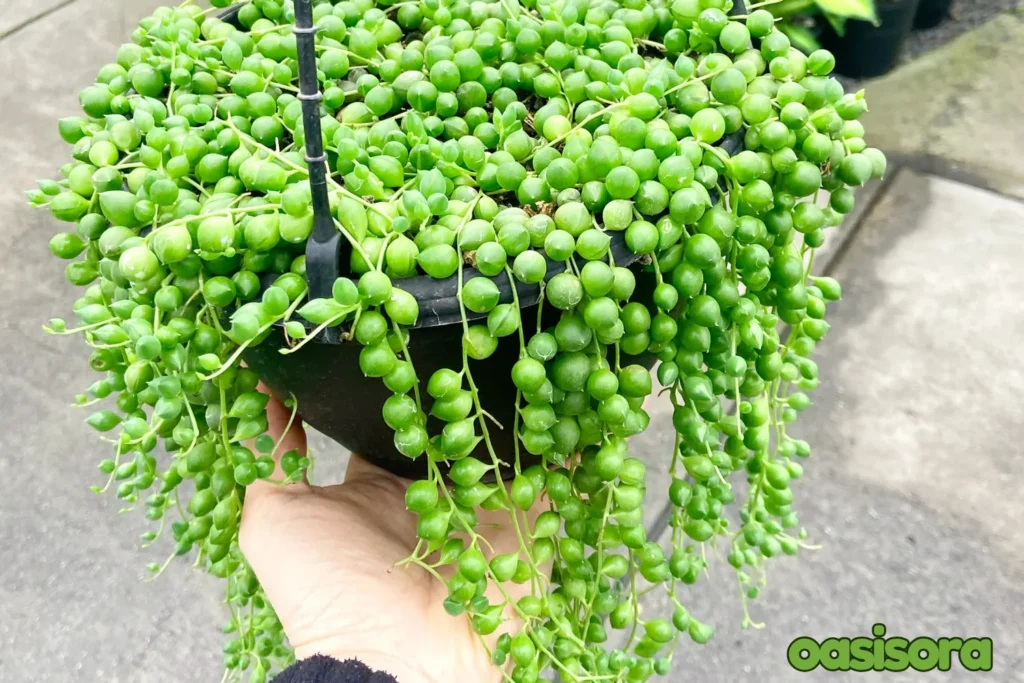
String of Pearls
Create a stunning display with this unique, straggling cactus and succulent idea! String of Pearls is suitable for hanging pots or baskets because it features tiny, spherical “pearls” on long, thin stems.
The little, unshowy flowers have a cinnamon-like, sweet, spicy scent. Weak roots give rise to lengthy stems which hang on the ground and create dense mats.
| Native to: | South Africa |
| Climate Regions: | Hot semi-arid weather (BSh) and Hot desert climates (BWh) |
| USDA Zones: | 9-12 |
| Soil Type: | Well-draining succulent mix |
| Pros: | It trails beautifully, needs little water, and thrives in hanging baskets. |
| Considerations: | It hates too much water, needs bright but not direct light, and can spread quickly. |
Rare Finds and Conversation Starters
Add some wow factor to your garden with rare and unusual plants! These fabulous gems will spark aesthetical appeal and make your outdoor space truly unique.
2o. Spiral Aloe (Aloe polyphylla)
AKA: Kroonaalwyn, Lekhala kharetsa, Many-leaved aloe
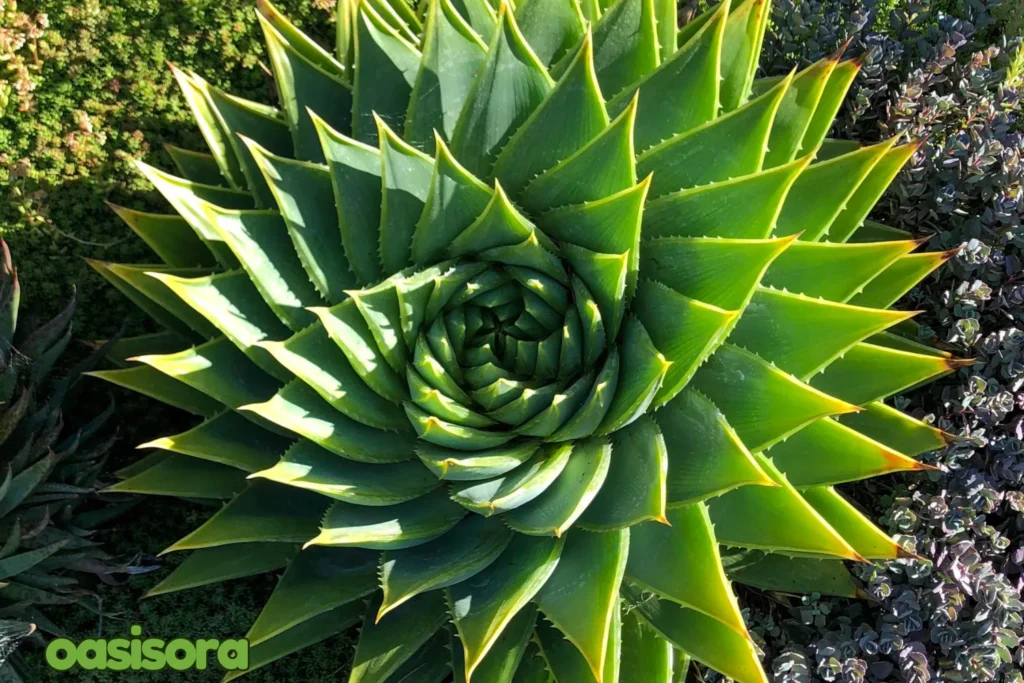
Spiral Aloe
This uncommon and distinctive cactus and succulent idea is excellent for adding a bit of spiral beauty to your yard!
The spiral aloe is a wonderful gem for collectors because of its gorgeous, spiral-patterned leaves, which make for a breathtaking display.
The plants don’t produce baby plants, but from their seeds, they can form small, dense groups. The thick, wide, serrated, gray-green leaves have sharp, dark tips and grow in five spiral rows.
| Native to: | Lesotho |
| Climate Regions: | Cold semi-arid climate (BSk) |
| USDA Zones: | 7-9 |
| Soil Type: | Well-draining succulent mix |
| Pros: | This succulent is a rare find! It is extremely low-maintenance, drought-tolerant, has a distinctive spiral design, and is a cactus collector’s dream. |
| Considerations: | It grows slowly, requires protection from cold, and cannot withstand excessive water. |
21. Bishop’s Cap Cactus (Astrophytum myriostigma)
AKA: Bishop’s hat, Bishop’s miter, Monk’s hood, Deacon’s hat, and Star cactus.
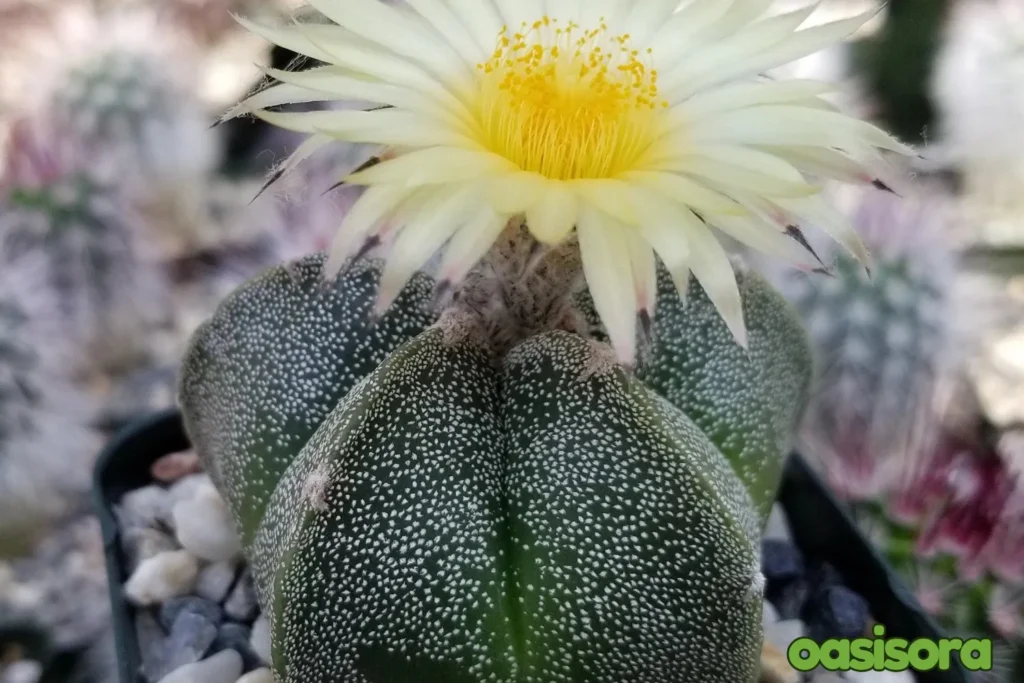
Bishop’s Cap Cactus
The Bishop’s Cap Cactus is a beautiful plant with circular stems structured like stars. It blooms throughout the summer in gardens but in the early spring in the wild.
The creamy yellow blooms appear close to the plant’s tip. After pollination, they turn into hairy, reddish fruits. But be patient – it can take up to six years for this cactus to bloom!
| Native to: | Mexico |
| Climate Regions: | Hot desert climate (BWh) |
| USDA Zones: | 9-11 |
| Soil Type: | Well-draining cactus mix |
| Pros: | It grows slowly, is drought-tolerant, has distinctive star-shaped patterns, and requires very little care. |
| Considerations: | It requires intense light to shine, hates excessive water, and may require protection in the winter. |
Creative Ways to Use Cacti and Succulents
Folks! I’ve shared with you my top 21 cactus and succulent ideas. Now, let’s chat about the ways to use these ideas in your yard. So, read carefully:
1. Outdoor Desert Gardens
Create a breathtaking outdoor desert garden by layering plants for a beautiful display. Mix and match cacti and succulents with different:
- Shapes
- Sizes
- Textures to add depth and visual interest.
Remember to:
- Consider the mature size of each plant
- Leave enough space for growth for a stunning and thriving desert garden!
2. Indoor Displays
Need indoor styling using your favorite cactus and succulent idea? Add a touch of elegance to your home with stylishly arranged succulents in:
- Terrariums
- Pots
- Hanging baskets
Get creative and experiment with:
- Different containers
- Soils
Décor to create a one-of-a-kind display that shows off your personal style!
3. Vertical Gardens
Take your succulent game to the next level with a stunning vertical garden! Use wall planters or frames to create a space-saving display that’s perfect for:
- Small rooms
- Apartments
- Offices
Just attach the planters to the wall, add your favorite succulents, and enjoy!
4. Seasonal Decor
My most adorable point! Seasonal décor! Add some desert flair to your holiday decor with cacti and succulents! Try using them as:
- Centerpieces
- Wreaths
- Ornaments
You can also get creative and decorate your succulents with:
- Lights
- Ribbons
Other festive embellishments to match your holiday style!`.
5. Gravel as a Landscaping Material
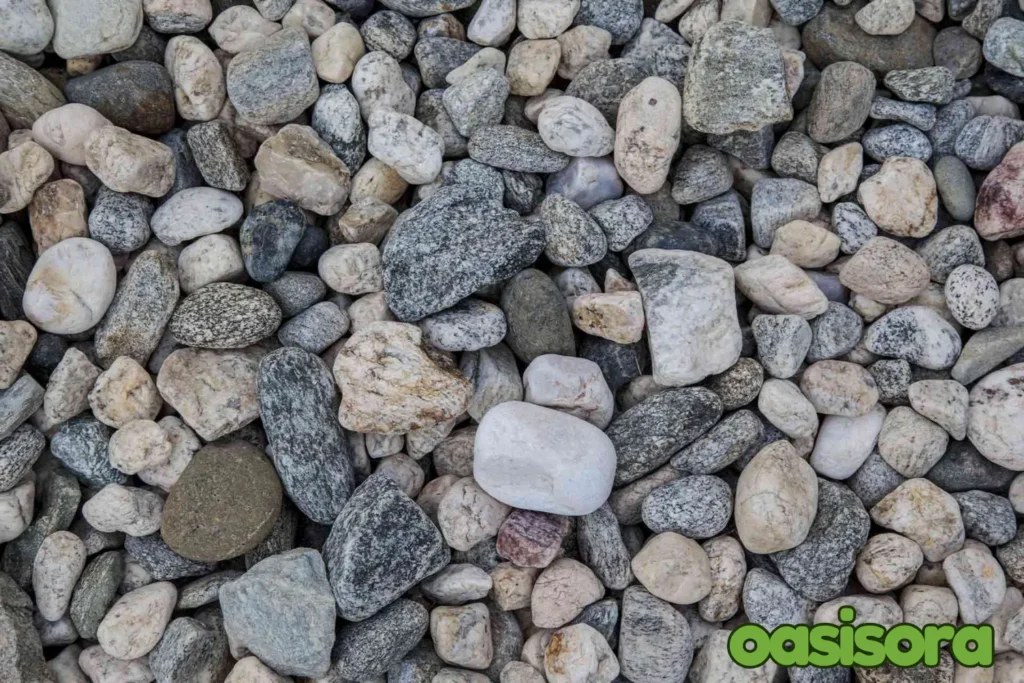
Gravel
Gravel is a most amazing thing for all kinds of landscaping projects. It’s that easy to maintain and doesn’t require any extra effort, extra water sprinkling, or frequent mowing. In addition, it helps quite a bit in the drainage of water while also keeping weeds away from garden soil.
What all can be done with this material: pathways, patios, and last but not least, your gardens too?
Here are the detailed perks of this amazing landscaping material:
- Low Maintenance
Gravel can save you a lot of time and struggle. It’s a hassle-free preference for you!
- Versatility
As discussed earlier, it can be used for yard paths, patios, and driveways. It’s a flexible material for numerous landscaping needs.
- Good Drainage
By preventing water pooling and promoting drainage, it’s perfect for areas with heavy rainfall.
- Weed Control
Gravel suppresses weed growth by blocking sunlight. Therefore, you can say that it’s a natural way to keep weeds in your yard under control.
- Aesthetics
The gravel comes in several sizes, colors, and consistencies. So, you can effortlessly pick your favorite and add visual interest to your outdoor space.
- Durability
Due to its long-lasting and rigid capacities, it doesn’t break down easily, so it’s a durable option for landscaping projects.
- Cost-Effective
Gravel is often more reasonable than other materials. It’s a budget-friendly option for landowners and gardeners.
- Easy Installation
You can install gravel yourself as it is less labor-intensive to fix. So, it’s a quick and easy solution for your landscaping needs.
- Climate Suitability
Gravel withstands extreme heat, cold, and wet conditions.
- Pest Control
If you want to hinder pest activity around plants, use gravel as it’s a natural way to keep pests under control.
6. Stones and Cacti
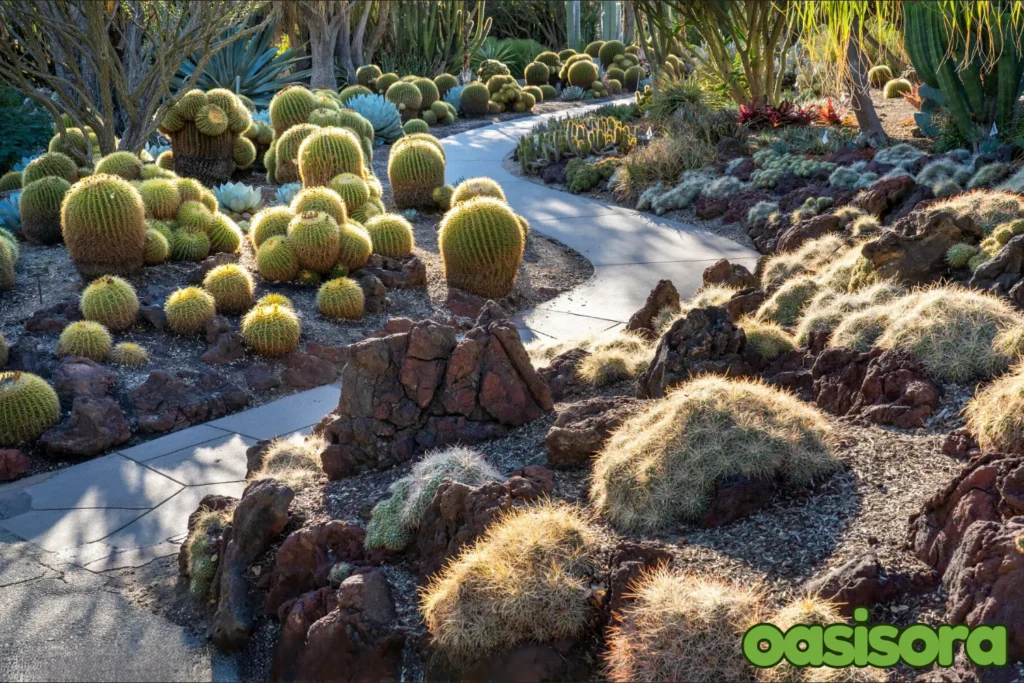
Cactus & Succulents with stones
Folks! Now let’s discuss another one of my favorite Cactus and Succulent Ideas!. That is, Stones and cacti. They are like an ideal match made in paradise. Together, they create a spectacular, simpler outdoor retreat that’s just right for hot and dry climates. Generally, these decorative stones provide beautiful walkways, pathways, borders, and decorative touches for the odd shapes and textures of cacti.
When you’re working with stones and cacti, you have to think about the colors and textures of both. Stonework creates a great border around cacti or an additional eye-catching decorative accent. The contrast between the smooth stones and the prickly cactuses will create a remarkable visual appeal.
Now, it’s time to chat about the perks of this combo:
- Stones can help retain moisture from the cactus, which is most vital as cacti love well-draining soil.
- They are a good addition to your cactus garden to enhance the look and to have a beautiful, practical space outdoors for leisure and enjoyment with nature.
- The stunning contrast of cacti against the backdrop of stones makes for a low-maintenance garden design that surely will impress the viewer.
- Moreover, the stones can help suppress weeds, reducing competition for your cacti. So, why not try this combo!
Hence, Stones and cacti are perfect partners for helping you create a stunning and low-maintenance outdoor space.
Essential Care Tips for Long-Lasting Plants
Lastly, learn simple secrets to keep your plants happy, healthy, and thriving:
- Give your plants the right amount of water. Different plants need different amounts, and the season matters too. Study how to water your plants accurately.
- Protect your plants from common issues including root rot and pests. Know the early signs and take steps to prevent them.
- Know when your plant needs a bigger pot. Look for signs like crowded roots or a plant that’s too big. Learn how to repot your plant with care.
Final Words
That’s all my folks! Create a stunning desert garden with these striking cactus and succulent ideas!
Our guide features 21 versatile cactus and succulent species, from intense focal points to compact varieties that are perfect for small spaces.
Each plant brings unique strengths, like architectural forms, seasonal blooms, and textural contrasts.
So, choose species matching your climate zone and growing conditions for a thriving, low-maintenance garden.
Get inspired by these desert landscape ideas and start planning your dream garden today to enjoy the beauty of these amazing plants!
FAQs
1. What is the best base to put under artificial grass?
A compacted layer of crushed stone or gravel is the best base for artificial grass.
2. What is best to lay under artificial grass?
Lay a weed membrane and a layer of compacted aggregate, like gravel or crushed stone, under artificial grass.
3. What is the cheapest sub-base for artificial grass?
A compacted layer of crushed stone, or MOT Type 1, is the least expensive sub-base alternative.
4How deep should the subbase be for artificial grass?
For artificial grass to have a stable basis, the subbase must be at least 75–100 mm deep.

11 thoughts on “21 Best Cactus and Succulent Ideas for Home and Garden”
Comments are closed.